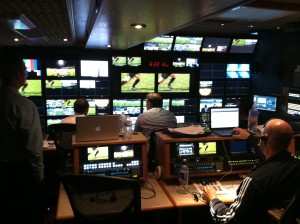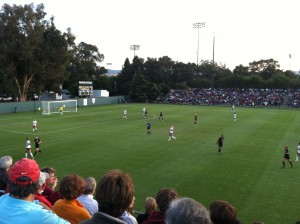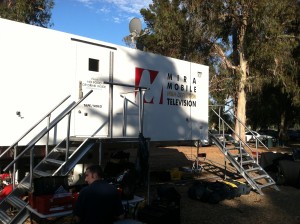Given that Stanford’s last three women’s soccer home openers have drawn an average of 1,101 fans, the sellout crowd of 2,084 that packed Cagan Stadium to begin the top-ranked Cardinal’s national title defense against Santa Clara on Friday was impressive in its own right. But the game’s real hallmark was that its paid attendance represented just a small fragment of its total audience.

The first event of Stanford’s 2012-13 athletic season was also the first live event televised by the Pac-12 Networks, an enterprise conceived just nine months ago that was capable of reaching 48 million homes as of its launch last Wednesday. The network will carry 850 live Pac-12 events — 350 of them nationally and the rest on its six regional feeds — this year alone, including every football and men’s basketball game not televised elsewhere.
But even with football season just two weeks away, the Pac-12 Networks decided to make its historic splash ahead of time with a women’s soccer game.
“We’re making a statement that we’re very proud of the Olympic sports’ success in the conference, very proud of having won more NCAA championships than any other, very proud of our recent success in London across the board,” said Pac-12 Commissioner Larry Scott just minutes before kickoff. “That’s part of the DNA of the conference, and that’s really one of the reasons for the TV network. Obviously we’ll serve fans that want to see every football game, want to see every men’s basketball game, but those sports get a lot of attention. The real game-changer is going to be that this network can provide exposure for sports that typically don’t get a lot — and massive exposure.”
“What better way than to start with the defending national champions, the preseason No. 1?” he added.
Stanford (1-0) looked the part in the second half, responding to a 1-0 halftime deficit by ripping six goals in 21 minutes. Five different goal-scorers contributed to the rout, with redshirt junior Courtney Verloo — who missed all of last season with an injury helping set up each of the first three tallies.

The Cardinal’s 51st straight win at home was more than just a national showcase for the conference. Pac-12 Networks Executive Vice President and General Manager Lydia Murphy-Stephans explained that the broadcast was also a chance to test the network’s full host of cameras and graphics packages; one of its new, decked-out Mira Mobile TV trucks even made the trip.
“We were joking about it the other day, that we had an English person put in the request and said we need the truck for football,” she said, admitting that some American football-specific details (such as first-down markers) will be tested later this week at Cal’s Memorial Stadium. “We’re not taking any risks; we have triple backups.”
“The launch for us was always going to be a build,” Murphy-Stephans added. “It wasn’t to launch with all the bells and whistles on day one; it was to have a succession of big games leading into the first full weekend of football. So this was the perfect event for us to do here.”
Even if the game was seen as a stepping-stone for the network, the conference didn’t hesitate to make a spectacle out of it, stenciling a celebratory logo on the field and handing out commemorative towels and T-shirts.
“Typically the first game of a season isn’t necessarily well-attended and people don’t know about it,” Murphy-Stephans said. “We felt like it was really important for us. We wanted to make some noise.”

Contributing to the noise at Cagan was the Stanford-Santa Clara rivalry, reflecting a local touch that will soon become familiar across the fledgling network. Pac-12 Networks has hired anchors and broadcasters with a background in the conference, including former Cardinal football defender Coy Wire ’01, one-time broadcaster Ted Robinson and current play-by-play man Dave Flemming ’98. (On Friday, Kelley O’Hara ’10, a recent Olympic gold medalist who won the Hermann Trophy playing soccer at Stanford, was interviewed in the broadcast booth.)
But despite the Pac-12 Networks’ early successes — the speed at which it launched, the breadth of its coverage, its nationwide reach and, of course, its potential to produce major revenue for Pac-12 members — its ambitious model has also drawn heavy criticism. A column in the San Jose Mercury News on launch day argued that, unlike the religious followings of some East Coast sports programs, Pac-12 fan bases will not produce the TV ratings needed to make the network a hit — an idea that Scott rejects.
“I believe there’s huge fan demand,” he said. “Going around the conference and talking to fans, there’s been a lot of frustration that events have been blacked out, been regionalized or just not covered at all. I think we had 90 men’s basketball games that weren’t available to be seen last year. And so from all the feedback I’ve gotten, this is something our fans really want.”
Murphy-Stephans argues that the conference’s bold response to such criticism is what allowed it to launch the network so quickly in the first place.
“I love reading that kind of stuff — it inspires me,” Murphy-Stephans said. “It’s like telling an athlete who’s uber-competitive, ‘You can’t do it.’”
“Three years from now,” she added, “people will look back at Larry Scott’s vision and say, ‘Wow. He and the presidents of the universities knew exactly what they were doing.’”
